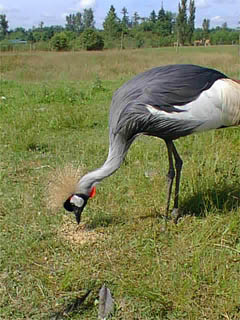Ostrich - Red Necked
Pink Neck Ostrich, Massai Ostrich Scientific Name: Struthio camelus massaicus
Sun, 6th July, 2025 - 1:36 am GMT
Sponsor Ads:

Alternative Name
Pink Neck Ostrich, Massai Ostrich Scientific Name: Struthio camelus massaicusBasic Info
Red Necked Ostriches can grow to be taller then a man average 300 pounds in weight. Mature males have black feathers with white tails while females have brown feathers. Ostriches have powerful legs which they use to reach great speeds and that act as a weapon. Red Necked Ostriches have long lifespans. In captivity, they live between 50 and 60 years on average.
Health
Like other ostriches, the Red Necked Ostrich requires a lot of space. Chicks should have at least 40 square feet per chick, while adults should be given least 200 yards in a rectangular shape so they can reach full running speed. Some ostrichs may be prone to having crooked legs, but this can be avoided with proper diet and exercise. Breeding In the wild, Red Necked Ostriches lay their eggs in a group nest laid by the male, who usually mates with a harem of four or five females. Like the Blue Necked Ostrich, the females (usually the dominant female) sits on the eggs during the day, while the male incubates the eggs at night. The alpha female often destroys surplus eggs. However, she is quite good at determining her eggs from those of the other females and they will often destroy those eggs laid by other females. Breeding is done regularly in captivity, though hatching and raising chicks may prove difficult. In captivity the breeding season usually occurs during warm months with longer days. A hen will lay an egg every other day for up to 18 to 20 days on average and then she will stop for a couple of weeks. She will start again if the eggs are removed from the nest for hatching in an incubator. Hens can lay up to 100 eggs in a season, but most lay 40 to 60 eggs. Chicks are mature at 6 months of age, but do not reach their full adult size until they reach 18 to 24 months of age. It should be noted that males will become aggressive during breeding season. Generally, they are only aggressive to other males.Habitat
N/ABehavior
The Red Necked Ostrich is known for the red coloration that develops on the neck and legs during breeding season. Of the three groups of Ostrich (African Black, Red Necked and Blue Neck) the Red Neck is typically the largest and they also lay the largest eggs. The Red Necked Ostrich, also known as the Massai Ostrich and in some places may be called the Pink Necked Ostrich, lives on the savannas and in the deserts of Africa. They are not considered an endangered species, but their numbers are dwindling due to human predation. During the mating season, males are territorial and may be aggressive. If one male intrudes on the domain of another, the intruded upon threatens the usurper by raising his wings and waving them back and forth in a demonstration called a "display." The males also give loud, roaring calls and inflate their necks while guarding their territory. Other than the territorial behavior shown by males during breeding seasons, the ostrich is no more aggressive than Emus or Rheas. They may be a bit more intimidating to some, however, because of their larger size.Origin
AfricaHistory
Ostriches have two main predators: lions and men. Many ostrich farms have opened in the Southern United States, where ostriches are raised for their eggs, hide, meat and feathers. In the 19th century, European settlers discovered the many uses for dead ostriches and started killing them. One Ostrich can yield up to 90 pounds of meat and over three pounds of feathers. Although they are still rather common, their population has dwindled greatly in the past 200 years. One Middle Eastern breed has been extinct since 1966. It should be noted that in the United States, most of the Ostriches kept in captivity are combinations of the three main groups, African Black, Red Necked and Blue Neck.Common Foods
They eat grasses, insects, trees and bushes.Sponsor Ads:
When a true genius appears in the world you may know him by this sign: that all the dunces are in confederacy against him. --Jonathon Swift
Ostrich - Red Necked
Coded by: BGID® | ALL RIGHTS RESERVED Copyright © 2000-2025
Disclaimer | Privacy | Report Errors / Contact | Credits








 Preparing For China. China is growing their military. China Military Technology - can it keep up with the US?
Preparing For China. China is growing their military. China Military Technology - can it keep up with the US?  versus
versus 

 versus
versus 
 This Thread is about the North Korean Military itself - the kind of army, navy, and air force they have.
This Thread is about the North Korean Military itself - the kind of army, navy, and air force they have. 
 versus
versus 
 versus
versus  versus
versus